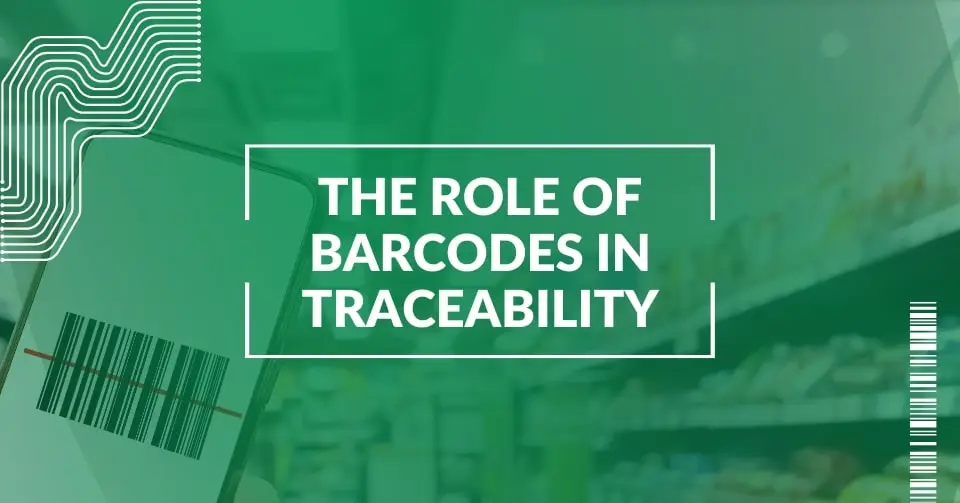In today’s fast-moving and demanding food industry, food manufacturers are searching for the best ways to ensure product traceability, safety, and compliance with regulations like FSMA 204. Barcode technology is one of the most powerful tools for achieving these goals.
Even though barcodes are often associated with checkouts and supermarkets, their functionality is way bigger. The technology enables businesses to track products at every stage of the supply chain, from farm to fork, making barcode technology a fundamental part of food traceability.
In this blog, I’ll explain how barcodes enhance food traceability and food safety, helping businesses stay compliant.
What Is a Barcode?
A barcode is a set of black-and-white lines (or patterns) that store product information. They are scannable and provide information about the product name, price, batch number, expiration date, etc.
Barcodes can be different and store various information for different purposes. Let’s see what types of barcodes are helpful for food traceability.
What are the types of barcodes used for food traceability?
- GTIN (Global Trade Item Number) – A globally unique number created by GS1 to identify specific products or services.
- UPC (Universal Product Code) – A series of black lines that go together with GTIN, making up a complete barcode. The product is identified by scanning UPC at the POS (point of sale).
- GS1-128 – A type of Code 128 barcode, uses GS1 Identification Keys to track product movement throughout the supply chain, aiding shipping, receiving, and warehouse scanning.
- QR codes – A two-dimensional (2D) barcode that can store more information than a one-dimensional (1D) barcode.
What Is the Role of Barcodes in Food Traceability and Safety?
Barcodes enable businesses to get a comprehensive overview of a product’s location in the supply chain, from production to distribution, in real time.
Barcodes make precise product tracking possible by encoding critical details like batch numbers, expiration dates, and production locations.
Additionally, barcodes help ensure supply chain transparency by enhancing stakeholders’ visibility and improving food safety and operational efficiency.
Barcodes boost recall management, making it faster to identify a contaminated product in the food supply chain and minimizing health risks and extra expenses.
Barcode technology is also useful when ensuring regulatory compliance. It helps food manufacturers adhere to the FSMA 204 rule, GS1 standards for traceability, and other regulations.
By storing all the information in a barcode, you contribute to food fraud prevention. Integrating barcodes with secure systems (like blockchain) helps ensure product authenticity.
Scannable QR codes or GS1 barcodes can boost customer confidence. The technology helps reassure customers about authentic product origin and food safety certifications, strengthening brand integrity and consumer loyalty.
Lastly, barcodes power digital transformation and provide automated data capture, which helps you speed up your operations, reduce human error, and improve food safety management.
Barcodes are fundamental to many processes, helping you automate them and providing a more precise overview of operations.
Success Story of Barcode Usage for Traceability and Safety
Barcodes are everywhere; we can’t imagine the manufacturing industry without them. Still, I’ve decided to find a specific case of how barcodes enhance food traceability and safety. Here’s the example from GS1 US.
Ocean Mist Farms faced a challenge in making its proprietary product identification system and
process that could integrate with the broader industry, including shippers, retailers, and distributors.
Using GS1-128 barcodes, Ocean Mist Farms improved internal workflows, including inventory control and sales order optimization, while providing essential traceability support to partners throughout the supply chain.
GS1 barcodes helped them save 25-35% processing time, improve transparency, accuracy, and food safety, and ensure that consumers receive the necessary traceability data.
What Are the Benefits of Using Barcodes?
Barcodes are not just necessary for a food business; they also bring benefits such as efficiency, money savings, improved efficiency, etc. So, what are the other advantages of barcode technology?
- Increased efficiency. Barcodes ensure faster and more accurate product identification and tracking.
- Improved compliance with global food safety regulations. Barcodes improve traceability, recall management, quality control, and other significant food safety and compliance aspects. Implementing the technology helps adhere to many regulatory requirements.
- Reduced food fraud risks. Barcodes help quickly identify the product authenticity and avoid different types of food fraud.
- Cost savings. Automation and real-time data access help save time and money.
- Consumer trust. Customers will trust you more if they get access to data such as the producer, origin, expiration dates, etc.
What Are the Challenges Related To Barcodes?
Implementing and using barcodes can have its pitfalls. Let’s see what you may encounter:
1. Data Accuracy
Data accuracy can be an issue if there are manual entry mistakes or poorly printed barcodes. It can lead to scanning failures and traceability gaps.
2. Supply Chain Complexity
Complex supply chains can become an obstacle when integrating barcode systems across global food chains, which can be challenging due to varying regulations and standards.
3. Barcodes Can Wear Out
Moisture, temperatures, or other environmental factors can damage barcodes on food packaging and make them impossible to read.
4. Adoption Barriers for Small Businesses
Implementation costs and requirements of barcode-based traceability solutions can challenge smaller food manufacturers.
5. Counterfeiting Risks
Yes, barcodes are indeed an excellent way to prevent food fraud. However, in some cases, barcodes can be duplicated or tampered with, making it challenging to detect fraudulent activities.
6. Costs
Barcode implementation includes costs for the software, equipment, training, etc. Small and medium-sized enterprises (SMEs) may find it costly. However, it’s still a considerable investment in the long run.
7. Ensuring Data Security
Information encrypted in barcodes must be well-protected. Otherwise, the data can be abused and exploited. To avoid potential breaches, ensure regular software updates and data encryption.
Obstacles and hardships happen, but not necessarily, and it doesn’t mean barcodes are impossible or not worth implementing. Knowing more about them helps prepare better.
Future Innovations in Barcode Technology
Technologies and the food industry are evolving, and so is barcode potential. There are increasingly more solutions for faster and more efficient barcode scanning for traceability and food safety.
- IoT and AI. AI will help recognize images, ensuring the barcodes remain scannable even if they are blurry or damaged. IoT devices linked to barcodes will enable real-time condition tracking, especially for temperature-sensitive foods like seafood, dairy, and meat.
- Blockchain. Traceability records can soon become temper-proof. Barcodes integrated with blockchain technology will ensure that food origin, processing, and distribution data are not altered.
- Data Security. Protecting data remains a top priority for food manufacturers and data protection will receive even more attention and effort.
- Sustainability. Being environmentally responsible is critical nowadays. Laser-etched barcodes are one of the sustainability solutions possible.
- RFID and NFC. RFID and NFC technologies will enable contactless and faster scanning.
Many of these innovations are made possible by traceability software for food manufacturing that integrates technologies such as IoT, AI, and more.
Enable GS1 Barcodes for Food Traceability With FoodReady
GS1 barcodes are more than black-and-white lines—they are a universal standard that ensures accuracy, efficiency, and food safety. For food and beverage businesses, GS1 barcodes enable seamless inventory tracking, enhance supply chain transparency, and ensure compliance.
FoodReady partnered with GS1 US, and now, as a GS1 US Solution Partner, we make it easy to enable GS1 barcodes. This helps you build consumer confidence, simplify distribution, and get your products on store shelves worldwide.
You can now get UPCs directly through our GS1-enabled software. We also offer a variety of other features, such as barcode scanning, inventory control, monitoring, food safety management, batch management, traceability, and recall, to help you comply with regulations and remain competitive in today’s market.
Ready to improve food safety and traceability with barcode technology? Get started with FoodReady today and experience the ease of using our GS1-enabled solution. Contact us now to learn more!
Final Thoughts
Barcodes are crucial for food traceability and safety. These scannable labels help ensure precise tracking, regulatory compliance, transparency, and efficiency.
Despite challenges like data accuracy, costs, wear and tear, or supply chain complexity, barcodes bring numerous benefits, such as improved recall management, food fraud prevention, financial improvements, and enhanced consumer trust.
Barcodes are already an indispensable part of food manufacturing, and advancements such as AI, blockchain, or IoT bring them even more potential.
If you plan to adopt barcode traceability and ensure food safety compliance, FoodReady software is here to help! Contact us to book a demo and see how you can enhance food safety and traceability.
FAQs
Two-dimensional barcodes can hold more data than 1D code.
Yes, they can. A QR code is an excellent solution for food traceability. It can store detailed product data, such as origin, batch numbers, and certifications.
There are exceptions. For instance, you don’t need a barcode if you sell the products directly to consumers without retail distribution.
It depends on the barcode type. 2D barcodes can store thousands of characters. 1D barcodes store very little information compared to 2D – 85 characters.








